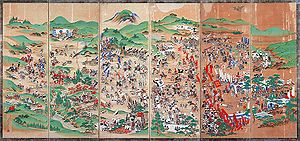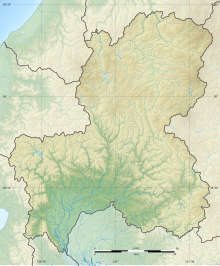
Back معركة سيكيغاهارا Arabic Batalla de Sekigahara AST Sekigahara döyüşü (1600) Azerbaijani سکیقاهارا دؤیوشو AZB Битка при Секигахара Bulgarian Batalla de Sekigahara Catalan Bitva u Sekigahary Czech Schlacht von Sekigahara German Batalo de Sekigahara Esperanto Batalla de Sekigahara Spanish
The Battle of Sekigahara (Shinjitai: 関ヶ原の戦い; Kyūjitai: 關ヶ原の戰い, Hepburn romanization: Sekigahara no Tatakai), was a historical battle in Japan which occurred on October 21, 1600 (Keichō 5, 15th day of the 9th month) in what is now Gifu Prefecture, Japan, at the end of the Sengoku period.
This battle was fought by the forces of Tokugawa Ieyasu against a coalition led by Ishida Mitsunari, from which several commanders defected before or during the battle, leading to a Tokugawa victory. The Battle of Sekigahara was the largest battle of Japanese feudal history and is often regarded as the most important.
Mitsunari's defeat in the battle of Sekigahara is generally considered to be the beginning point of the Tokugawa shogunate, which ruled Japan for another two and a half centuries until 1868.[8]
- ^ "関ケ原 戦いの場所は「青野カ原」 合戦直後の文書に記載". 毎日新聞 (in Japanese). The Mainichi Newspapers. 2016. Archived from the original on 2016-04-04. Retrieved 26 June 2024.
- ^ Cite error: The named reference
Naomasa; Watanabe Daimon4was invoked but never defined (see the help page). - ^ a b Davis 1999, p. 204.
- ^ a b Bryant 1995.
- ^ 『関原軍記大成』
- ^ a b Tsunoda Akio (2023). "【どうする家康 予習】関ヶ原合戦…江戸幕府の公式記録『徳川実紀』が伝える当日の様子を紹介:2ページ目". mag.japaaan.com (in Japanese). Japaaan Magazine. pp. 1–2. Retrieved 17 June 2024.
'The Chronicles of Toshogu Shrine' Volume 4, Year 5 of the Keicho Era 'The Battle of Sekihara'
- ^ 『関原合戦記』
- ^ "Battle of Sekigahara | Summary, Facts, & Outcome | Britannica". www.britannica.com. Retrieved 2022-06-22.
Cite error: There are <ref group=lower-alpha> tags or {{efn}} templates on this page, but the references will not show without a {{reflist|group=lower-alpha}} template or {{notelist}} template (see the help page).


